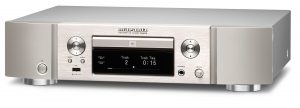What to be aware of with multiroom-capable network media players with integrated content sources

Marantz ND8006 multiroom network CD player – an example of one of these multiroom network media players with an integrated programme source
A few hi-fi equipment manufacturers who have an investment in a network-based multiroom audio platform are offering or intending to offer network-media-adaptor components with integrated traditional content sources.
The first example of this kind of unit is the Marantz ND-8006 network CD player which works with the HEOS multiroom platform at least as a multiroom audio player. Then Yamaha just premiered the MusicCast Vinyl 500 which combines a turntable for playing those vinyl records and a network media player in the one chassis, something that is intended to appeal to the hipster vibe or the 40-60-year-old who fondly remembers playing or listening to those old records from their youth. Here, this unit can play the sound from a record on its platter or an online source through an amplifier via its line-level outputs. Or it can be set up to stream the sound from that same record or an online source to a network-based multiroom system based on that manufacturer’s MusicCast platform. Let’s not forget that there are some DAB+ digital-radio / Internet-radio tuners out there that are or will be part of a network-based multiroom audio platform of some sort, most likely the UNDOK platform offered by Frontier Silicon like the Sangean WFT-3 Internet radio tuner. The same situation can also apply to those multiroom network media players that have a USB port so you can play what’s on a USB memory key or flash drive through your multiroom setup.
Eventually, more of these manufacturers will offer at least one of these devices in their product ranges, whether they have an integrated CD player, turntable or broadcast-radio tuner.
What you can do
In these cases, you will hear the online sources and the device’s integrated programme source through the same input that it is connected to on the sound system. Some of these system may allow you to stream content from another sound system that is part of your multiroom setup, including a source connected to the AUX inputs of one of the multiroom speakers in your setup.
Some of these devices will also allow you to stream the device’s integrated programme source through the multiroom system, which can be a single-box solution for bringing legacy packaged media or broadcast radio to the speakers in your multiroom setup. Depending on the device, there may be the ability to stream a source connected to an external-device input that the device is equipped with to the multiroom system. It may also apply to devices that have a Bluetooth A2DP link for use with smartphones.
Streaming sources connected to the amplifier that the multiroom device is connected to
You may find yourself exposed to a limitation caused by the other sources connected to or integrated in the sound system that this device is connected to not being available to the multiroom setup. This is more so where, for example, you have connected it to a stereo receiver or an amplifier that has a turntable connected to its PHONO input.
There may be an exception to the rule for this situation if your network media player has a line-level input for external devices and your sound system has a line-level output that is typically used for connecting a recording device. Here, you could connect the network device’s line-input to your sound system’s line-output or tape-output, perhaps wiring the device to the sound system as if you are connecting a recording device.
You may run in to problems if your amplifier’s tape loop is occupied by a recording device, perhaps a cassette deck. This is where you may not be able to make use of the amplifier’s tape output to stream what is being played in your cassette deck unless you keep switching wires around. Rather, you may end up using a switch box for this purpose to create a virtual “tape monitor” switch for your network media adaptor’s line input.
If you are using a PA or sound-reinforcement setup with a mixing desk, you cannot use the same network media device to play an online source or source integrated in that device and share the system’s output to a multiroom speaker setup. Such an arrangement can lead to acoustic feedback which results in a howling sound through the system if the line-level input is selected on the network media device while it’s connected to any of the mixer’s outputs. Rather, it would be better to use a separate network media adaptor which has a line input for the purpose of creating an audio on-ramp to your network multiroom setup.
Conclusion
Once you know what these multiroom-capable network media players that have integrated legacy content sources are capable of, you can then make sure they are able to work as part of your sound system and your multiroom speaker setup.

